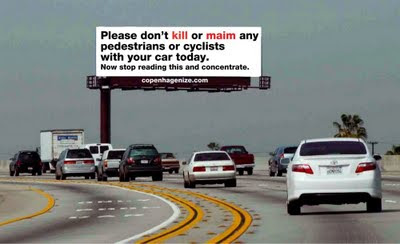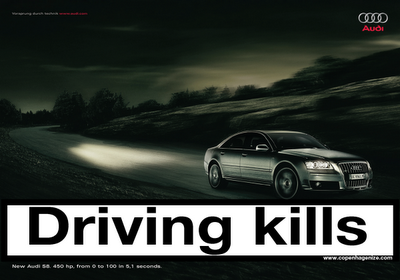

Placing responsibiliy where it counts. There’s something I’ve been wondering about. I’ve noticed that the majority of traffic ‘safety’ campaigns seem to focus on everything except the bull in the china shop - the automobile. It’s a global tendency, stemming from the seemingly irreversible prescence of cars and trucks. I find it odd that so few campaigns actually place the focus firmly on the problem: the large, heavy, dangerous machines that rumble about our streets and the people who seem to have difficultly controlling them. The billboard prototype above is a logical illustration of how traffic safety campaigns should be focused.
In Frederiksberg, the city in which I live - not surprisingly it is staunchly conservative/right wing - these posters were slapped up recently. It rhymes in Danish, but reads "She checked her text messages, and died in the process."
What a stupid girl. Cars are everywhere and they're not going anywhere anytime soon. It's her own damn fault for impeding their route. Think of the poor motorist who had no choice in running her down. He/she was just regular citizen on their way to or from work. Not only were they forced to suffer the mental anguish of killing a text-messaging pedestrian [shockingly sans walking helmet], but they were made to wait around at the scene of the accident, be interviewed by the police and they were probably late for dinner/work.
So someone let a bull into society's china shop. We all realise that and it doesn't look like the bull is going anywhere. All the fragile fine china on the shelves is getting knocked about and smashed on a regular basis. [An estimated 1.2 million people are killed in motor vehicle accidents every year around the world].
It seems quite ridiculous that nobody is talking about the bull. Instead there is constant talk of wrapping up all the pieces of porcelain in thin bubble wrap and tsk-tsking about how dangerous it is to even CONSIDER placing fine china on the shelves of a china shop now that there's a bull stampeding about. Meanwhile the bull just shit on the floor in aisle 9 and tipped another shelf over. Crash bang boom. Here's a radical idea. If it proves too difficult to remove the bull entirely from the china shop, what about lassoing it and tethering it to a fixed object? Restricting its movements and not letting it run about? Castrating it and calming it? If need be, creating a pen within the china shop where it can graze, out of reach of the china? The automobile industry wants us to forget the bull. And the proud stallion, ram, birds of prey, big cats, mythical dragons. These poor innocent creatures. It's a shame that they can't just freely roam about without all these soft, squishy obstacles that get in their way. Their marketing has succeeded and it's not surprisingly that the industry is among the most fervent advocates for making cycling appear more dangerous than it is. Society has turned a blind eye to the bull. Even in traffic safety campaigns that employ scaremongering about car accidents, the focus is often on YOUR safety and that of the other passengers. Rarely the external problem of killing innocent people. I've been trying to think about examples of adverts that are focused on the actual problem and that place responsibility for the heavy hitters in the traffic equation, rather than the "soft traffic", as we call pedestrians and cyclists in Denmark. One example, or rather exception, is the annual campaign above. It appeared for many years when school was starting, featuring various kids. "Watch out for Laura. She's new in the traffic" But it's been difficult to find other examples. Does anybody know of any out there?A recent public service campaign from Wales, above, is another exception. It focuses on the latest cause celebre - the dangers of texting while driving, but it graphically show how dangerous driving is. It is also the greatest public service campaign for advocating motoring helmets. Have a look and see, despite the seatbelts and airbags, why motoring helmets have been developed first by an Australian company in the 1980's and later at the University of Adelaide in Australia. [after an Australian government study showed that 25% of all car fatalities could be avoided if the motorists had worn helmets - despite seatbelts and airbags. That's over 250,000 lives saved every year globally, and 10,000 in the US alone] Virtually everyone involved in the accidents has a head injury of some sort.
Like our previous post about applying logic to the case and placing health warning labels on all cars and trucks, a change of focus about the very real possibility of killing innocent people while driving would be an effective way to place responsibility in the right place, as well as encourage motorists to choose alternative transport forms. There are numerous ways of taming the everpresent bull in society's china shop. There are congestion charges in place in many cities, discouraging motor vehicles and encouraging people to take public transport or cycle. Dozens and dozens of cities around Europe are actively implementing lower speed limits. Down to 20 or 30 km/h in built-up areas and the effects on the number of accidents is positive. Sadly, this very simple idea is not being considered in Copenhagen.
A recent BBC article completely ignores the bull, whereas in Denmark and the Netherlands drivers of large trucks [HGVs/Heavy Goods Vehicles] are being made to improve their mirrors, install cameras and warning sensors and there are other technological advances that will improve safety for pedestrians and cyclists.
There are changes to laws, like in Denmark and the Netherlands that place the blame firmly on the automobile in accidents, unless it can be proven otherwise. The idea is simply that the person in the most dangerous vehicle has the most responsibility.What started as a "what if" idea at the Dutch Cyclist Federation - Fietsersbond - is now evolving rapidly into a real project. External airbags on cars in case of collisions with pedestrians or cyclists. The project has recieved a great deal of funding and simulations have been produced. A crash-test dummy simulation is on the calendar for later this year.
All in all, it's high time that we turned around, looked at the bull and did something about it. The sooner, the better. It's not rocket science, it's merely a question of changing our marketing tactics.







